Teaching and training program
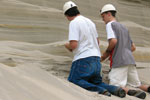 |
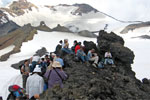 |
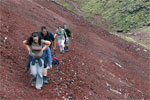 |
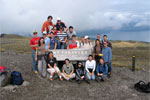 |
GEMOC's teaching program aims to:
- provide undergraduate and postgraduate students with a broad, integrative understanding of Earth architecture and processes, bridging the discipline boundaries of geology and geophysics
- train undergraduate and postgraduate students in new conceptual approaches and the applications of advanced technology, including geochemical analysis techniques and the integrated field and laboratory use of geographic information systems (GIS)
- develop international links in teaching programs (especially postgraduate) relevant to GEMOC’s goals
- develop formal tailored course work components at postgraduate level which also can be packaged for distance education delivery and as short courses available to the mining industry
- enhance the pool of high quality geoscience graduates by restructuring academic programs to attract a new clientele
Highlights 2004
Curriculum Development
- Our tailored problem-based learning (TPBL) units GEOS116 Marine Geoscience and GEOS115 Earth Dynamics, Materials and the Environment continue to be revised and were, again, well received by students. The format includes lectures, problem-based workshops and traditional skill-based practicals. The workshops are completed as group work projects and are modelled on real-life scenarios with the students adopting a role as part of a geoscience team.
- GEOS377 “Environmental Geology” was redesigned with the help of a Macquarie University Teaching Development Grant. The project was titled: Bringing the workplace into the classroom – the redesign of GEOS377 using Tailored Problem-Based Learning and real workplace scenarios. This unit utilised the TPBL model but also aimed to introduce professional and generic skills that are seen as important by employers of graduates in the environmental geology area.
- The unit is based around 3 projects that develop scientific problems from an initial tender stage to the preparation of final reports. All work is completed as group work with students taking the role of small consulting teams. GEOS377 Environmental Geology is a core unit of the new Bachelor of Enviromental Science in Environmental Geology.
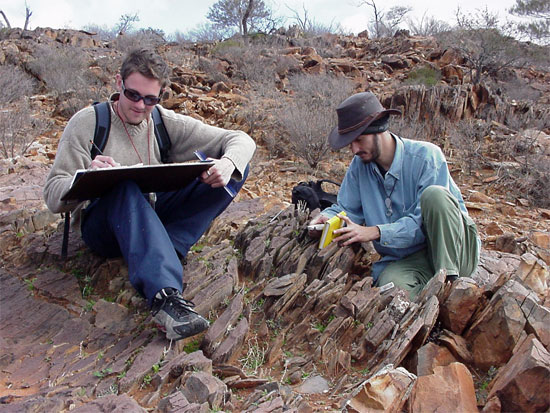
Mapping an outcrop near Broken Hill, GEOS307 Field Geology and Mapping.
Nathan Daczko co-ordinated three units in 2004 - GEOS115, GEOS230, and GEOS307. GEOS230 Field and Laboratory Studies in Geoscience was run for the first time. This unit uses projects integrated with lectures and laboratory classes to develop the theoretical knowledge and hands-on experience needed to map, describe and interpret rocks (and other materials – eg soils, fossils, etc) in the field and the laboratory. Laboratory techniques covered include petrographic microscopy, x-ray diffraction, x-ray fluorescence, electron microprobe, geoscience computing and the construction and interpretation of geological and other maps. A new field trip to the historic gold mining town of Hill End provided an excellent opportunity to apply these laboratory practices in the field. This new unit attracted 19 students from the Department of Earth and Planetary Sciences in 2004 and will be offered externally for the first time next year.

Mapping an area at Hill End, GEOS230 Field and Laboratory Studies in Geosciences.
- GEOS307 Field Geology and Mapping was again run in the Broken Hill/Olary region in conjunction with the University of Sydney. Field studies in the Broken Hill/Olary region allow students to gain experience mapping in a geological province not encountered before in their course. The unit attracted 21 students from the Department of Earth and Planetary Sciences in 2004.
- Another successfull field-based unit GEOS373 “Volcanic Geology Fieldwork”, centred on a trip to New Zealand, was run again in 2004.
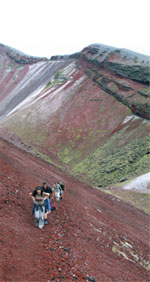
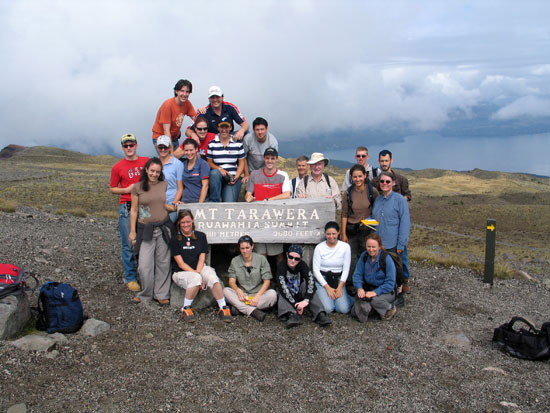
Scaling the heights of Mt Tarawera on the GEOS373 "Volcanic Geology Fieldwork" trip to New Zealand.
The use of computer packages and web interfaces in Earth and Planetary Sciences continues as a routine feature of content and skills delivery. Both geology and geophysics units incorporate packages used by industry into classroom and field teaching. Our portable computer lab allows students access to up-to-date computer software for use in both the classroom and field.
Geophysics teaching progress 2004
- Collaboration in teaching and research between GEMOC and Geophysics at the University of Sydney continues.
- The named degree, Bachelor of Geophysics, continued in 2002 after its inception in 1998 to increase the visibility of Geophysics. It has evolved into the advanced geophysics stream in the Bachelor of Science degree.
- The Bachelor of Technology in Exploration Geoscience has a Geophysics strand initiated in 1999, streamed from second year level (see flow sheet in Appendix 6).
- Use of an extensive pool of GPS units for undergraduate (and postgraduate) fieldwork continued.
- Extended implementation of new seismic, gravity and resistivity equipment for student field projects in exploration, groundwater, environmental and engineering geophysics.
- Equipment upgrades funded by Macquarie University over the last five years have resulted in an excellent array of new instrumentation. Acquisitions include:
- GEOMETRICS G856 Proton Precession Magnetometer
- GEOSOFT, MODELVISION, EMVISION, ERMAPPER and Claritas software was either purchased or upgraded
- Seismic trigger cable modifications
- ABEM SAS4000 Resistivity System and a ABEM LUND system
- ASHTECH Z-Xtreme Differential GPS system
- DUALEM Frequency Domain EM System
Outcomes
The introduction of new units and restructuring of existing undergraduate units at Macquarie as described in each Annual Report has achieved the goals of attracting new clientele. However, this is within an environment of a contracting pool of science undergraduates. Despite this, GEMOC core units at 100 level have maintained average enrolments. Reorganisation of course structures and acquisition of teaching infrastructure (computers, high-technology instruments, GIS units) have increased the visibility of geoscience and have resulted in the presentation of geoscience with an interdisciplinary and innovative approach using state-of-the art technology and concepts.
Teaching and training program
GEMOC Honours
THE UNIVERSITY MEDAL was awarded to GEMOC honours student Kathleen McMahon in 2004 for her honours thesis “Seismic reflection studies of the Amery Ice Shelf, East Antarctica”.
The following honours projects in GEMOC were commenced mid 2004:
Stéphanie Carroll: Plutonism and metamorphism at the root of a Cretaceous magmatic arc, Fiordland, New Zealand
Kirsty Liddicoat: Chemical and isotopic signatures of opal genesis at Lightning Ridge, NSW
Alice Plioplis: The geology of the Frampton Volcanics
Penelope Littlewood: Geochemistry of the Phoenix Tungsten mine, Frogmore NSW
The following Honours projects are relevant to GEMOC in 2005:
Zoe Demidjuk: A geological study of the Newer Volcanics Province of southeast Australia
Martyn Allen: The 3D shape of the Mole Granite and the thickness of the Torrington Pendant
Natalie Staib: The geophysical expression of Tertiary igneous activity in south-central Queensland
Heather Skeen: Finding graves: The best methods for grave detection using geophysics
Glenn Gooch: A geophysical investigation of the Hunter Fault, New South Wales, Australia, using gravity and magnetics
Dania Perez: An EMP and ICPMS study of some glassy rocks of the New England Fold Belt
Gemoc offers scholarships for students with excellent undergraduate records who are carrying out GEMOC-related projects.Teaching and training
program GEMOC postgraduate
 |
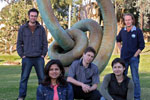 |
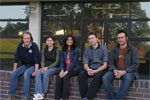 |
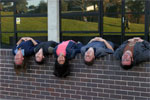 |
See advertisement for GEMOC postgraduate opportunities in Appendix 7.
GEMOC POSTGRADUATE STUDENTS once more provided a high profile for our postgraduate training through 2004 with presentations at international conferences including the 14th Goldschmidt Conference in Copenhagen (Denmark), 32 International Geological Conference in Florence, and the 17th Australian Geological Convention (Hobart)
GEMOC’s active international exchange program continued including the program with the University of Jean Monnet, St Etienne. Guillaume Delpech’s successful thesis defence was held in June and Stéphanie Touron continued her co-tutelle PhD project. A new co-tutelle PhD student commences in 2005.
completed
Olivier Alard (PhD): Trace element geochemistry and mantle domains, emphasis on PGE and Re/Os; IPRS with MUIPRA stipend (graduated 2001)
Sonja Aulbach (PhD): Depletion and metasomatic processes in cratonic mantle; IPRS with MUIPRA stipend (submitted October 2004)
Kari Anderson (PhD): Defining the APWP for early to mid Palaeozoic eastern Gondwanaland: paleomagnetic pole information from the northern Tasman Orogen; IPRS with MUIPRA stipend (graduated 2003)
Elena Belousova (PhD): Zircon and apatite geochemistry: applications to petrology and mineral exploration; APA and sponsorship by Rio Tinto (graduated 2000)
Eloise Beyer (PhD): Contrasting characteristics of Proterozoic and Phanerozoic mantle types; Field assistance from Ashton Mining (graduated 2003)
Rondi Davies (PhD): East Australian Diamonds: Characterisation and origin; Sponsored by Rio Tinto, Kennecott Canada (graduated 1999)
Guillaume Delpech (PhD): Isotopic characteristics of lithosphere processes beneath Kerguelen; Co-tutelle with University of Jean Monnet, IPRS with GEMOC stipend and EURODOC scholarship (graduated 2005)
Oliver Gaul (PhD): Composition of the lithospheric mantle beneath Australia; APAI collaborative with Stockdale Prospecting, CSIRO EM (graduated 2000)
Bin Guo (PhD): An integrated geophysical investigation of the Hunter-Mooki and Peel Fault; IPRS with MUIPRA stipend (graduated 2005)
Joanne McCarron (MSc): Mantle xenoliths from Queensland and South Australia (graduated 1997)
Bertrand Moine (PhD): The role of fluids in the genesis, segregation and crystallisation of intraplate oceanic mantle magmas: implications for crustal accretion; Co-tutelle with University of Jean Monnet (graduated 2000)
Mark Pirlo (PhD): Australian groundwater geochemistry; applications to heat flow and exploration; APA and Queen’s Trust for Young Australians Award (graduated 2003)
Esmé van Achterbergh (PhD): Trace-element fingerprints of metasomatic processes in lithospheric mantle (graduated 2005)
Shixin Yao (PhD): Chromite as a petrogenetic indicator in ultramafic rocks; Collaborative with Rio Tinto (graduated 2000)
current
Brad Bailey (PhD): Law Dome: Ice and Crust Mass Balance Studies
Steven Cooper (PhD): Diamonds and mantle-derived minerals, NW Australia and South Australia (commenced part-time 2003)
Kathleen McMahon (PhD): Fracturing and deformation along the Amery Ice Shelf: A seismic study (commenced 2001) (see Research Highlights)
Luke Milan (PhD): The emplacement, pressure-temperature-time path and structural evolution of lower crustal gneisses in Fiordland, New Zealand (commenced 2004)
Valeria Murgulov (PhD): Crust-mantle evolution and metallogeny, eastern Australia; APA (commenced 2003) (see Research Highlights)
Nenad Nikolic (PhD): Evolution of crust-mantle systems near a young rift: NW Spitsbergen, Norway (commenced 2004)
Kathlene Oliver (MSc): Depth and subsurface shape of the Dundee Ignimbrite (part-time, commenced 2001)
Will Powell (PhD): Nature of the lithospheric mantle in the New England Region, NSW; APA (part-time, commenced 1997)
Sonal Rege (PhD): Trace-element geochemistry of diamonds; IPRS with iMURS scholarship (commenced 2002)
Stephanie Touron (PhD): Geochemical fingerprints of the mantle beneath the Massif Central; IPRS with MURAACE scholarship (commenced 2001)
commencing 2005
Jacques Batumike (PhD): The origin of kimberlites from the Kundelungu region (D.R. Congo) and the nature of the underlying lithospheric mantle
June Chevet (PhD): Gabbroic rocks from the Kerguelen Islands (Indian Ocean): a petrologic, geochemical and isotopic investigation of their origin
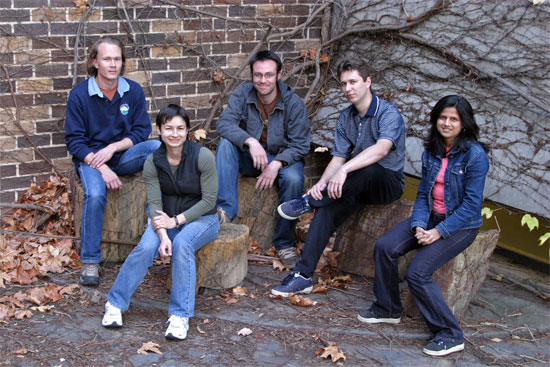
Some of GEMOC’s 2004 postgraduate students: Will Powell, Valeria Murgualov, Luke Milan, Nenad Nikolic and Sonal Rege.

 GEMOC ARC National Key Centre
GEMOC ARC National Key Centre